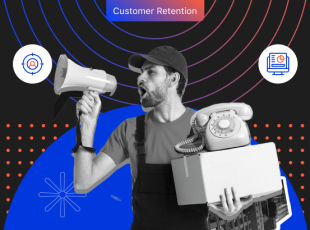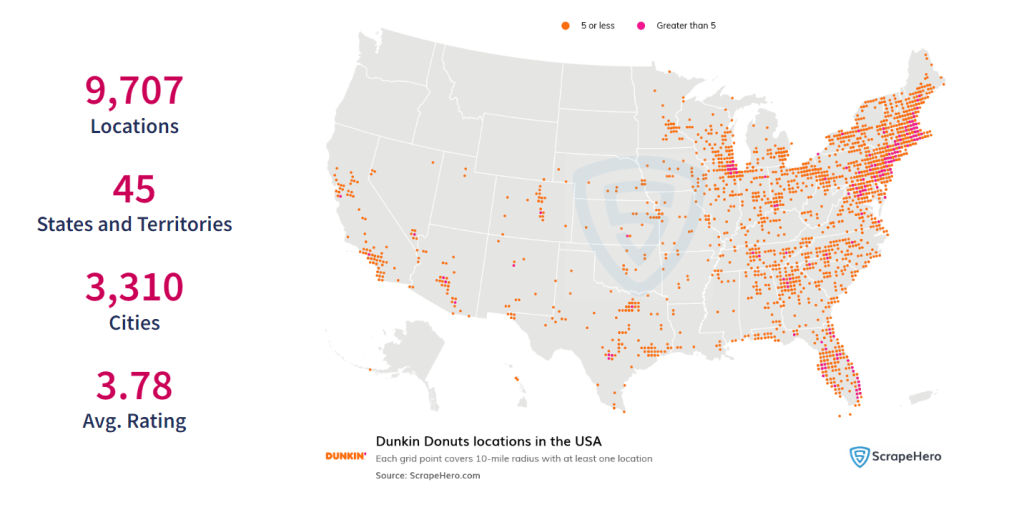
Dunkin’ Donuts has long been a household name, but have you ever wondered what powers its global success? The answer lies in a powerful, often overlooked force: data. Dunkin’ Donuts realized that, in order to cater to people, they need to truly understand their customers—and what better way to know people than through data?
While it might seem like a collection of numbers, when analyzed closely, data reveals invaluable insights into customer preferences, behaviors, and patterns across multiple stages of a customer journey and contributing to an effective lifecycle marketing. Read on to discover how data serves as the cornerstone of effective lifecycle marketing and how Dunkin’ successfully implemented it.
Customer Lifecycle Marketing is a strategy that engages customers at various stages of their relationship with a brand—from initial awareness to loyalty and advocacy. By leveraging customer data, businesses can tailor their messages and offers to meet the needs and preferences of customers at each lifecycle stage.

5 overall stages of a customer journey
Dunkin’ Donuts has built a global brand presence by effectively using data to drive customer loyalty as well as increase its customer base. With over 12,600 locations in 40 countries, Dunkin’ relies on data to make informed decisions about everything from product offerings to marketing strategies, ultimately driving both customer engagement and customer retention.
Dunkin’ Donuts collects a wealth of information through digital channels, including their mobile app, website, and loyalty program. This data allows Dunkin’ to gain deep insights into customer behavior, such as:
By using this data, Dunkin’ can identify which lifecycle stage a customer is in and create targeted marketing strategies for each segment. For example, Dunkin’ can offer special deals to a new customer to encourage repeat purchases or send loyalty rewards to loyal customers who frequently engage with the brand. This data-driven approach also plays a critical role in customer retention, ensuring that customers continue to engage with the brand over time.
Another way Dunkin’ uses data is by optimizing store layouts to streamline customer experiences and increase sales. By analyzing foot traffic patterns in their stores, Dunkin’ can strategically position high-demand products such as coffee and breakfast items near the front or high-traffic areas. This makes it easier for customers to quickly find popular products, improving their experience and encouraging repeat visits.
For example, Dunkin’ may place quick-grab items like ready-made coffee or pre-packaged snacks near the checkout area to encourage impulse purchases. This not only increases the average transaction value but also enhances the overall experience.
Dunkin’ Donuts also employs dynamic pricing to optimize its sales strategies. Using real-time analytics, Dunkin’ can adjust prices based on various factors such as demand, time of day, and location. For instance, during peak morning hours, Dunkin’ might adjust coffee prices slightly higher in busy city locations where demand is higher. Conversely, during slower periods, Dunkin’ can offer discounts or promotions to encourage customers to visit.
This dynamic pricing model helps Dunkin’ maximize sales while maintaining customer satisfaction.
A critical component of Dunkin’s customer engagement strategy is its mobile app and loyalty program, which together provide Dunkin’ with a treasure trove of data. The Dunkin’ app has been downloaded over 20 million times. The app features:
Mobile transactions account for more than 7% of all transactions at Dunkin. Furthermore, customers who use the mobile app tend to spend more on average than those who don’t, showcasing the effectiveness of Dunkin’s digital and loyalty strategies in driving sales and increasing customer retention.
Email marketing is another critical component of Dunkin’s customer lifecycle marketing strategy.
For new customers, Dunkin’ sends welcome emails and offers that encourage them to make a second purchase. These emails often include special promotions, such as a discount on their next order or extra loyalty points.
For existing customers, Dunkin’ uses email to nurture the customer relationship by sending updates on new products, seasonal items, and limited-time offers that align with their preferences. The goal is to keep them engaged and encourage repeat purchases.
For loyal customers, Dunkin’ sends personalized offers, such as birthday discounts or exclusive rewards, to reward their loyalty and deepen their relationship with the brand. Dunkin’ also uses email to remind these customers to redeem their loyalty points, ensuring they feel valued and appreciated.
By tailoring email content to the each stage of the lifecycle journey, Dunkin’ ensures that its email marketing efforts are both relevant and effective. It has been found that targeted promotions like these led to higher purchase rates and increased average spending among Dunkin’s customers.
Dunkin’ Donuts’ data-driven lifecycle marketing strategies have produced significant benefits, both in terms of customer satisfaction and business performance.
Dunkin’ understands that personalization is key to creating a positive customer relationship. By using customer information to tailor marketing efforts to individual preferences, Dunkin’ can provide more relevant and timely offers, which enhance the overall customer experience and build long-term loyalty.
For example, Dunkin’ frequently sends personalized offers to new customers through its mobile app and email campaigns. These offers—based on individual preferences and past purchasing behavior—ensure that customers receive promotions relevant to their tastes. For instance, repeat customers might receive exclusive discounts or deals, while existing customers might be incentivized to increase their purchases with time-limited promotions.
Loyal customers, in particular, benefit from Dunkin’s birthday rewards, where they receive a free drink during their birthday month, making them feel valued and appreciated.
By engaging customers at every stage of the Lifecycle Journey , Dunkin’ is able to increase the Customer Lifetime Value (LTV)—the total revenue a customer is expected to generate over their relationship with the brand.
Dunkin’s loyalty program is a key driver of LTV. Both new customers and existing customers are incentivized to make repeat purchases through the rewards program, where they earn points for every transaction. This encourages more frequent visits and larger purchases, particularly among loyal customers who are eager to unlock rewards. As a result, Dunkin’ app users tend to spend more than non-app users, contributing to higher LTV and overall revenue growth.
Customer retention is one of the most important aspects of lifecycle marketing, and Dunkin’ excels in this area. By continuously engaging customers with personalized offers, loyalty rewards, and a seamless mobile experience, Dunkin’ retains more customers over time.
Returning customers spend 67% more than new customers. Thus, Dunkin’s focus on retention through data-driven strategies allows the brand to maximize profits while reducing acquisition costs. By using data to monitor the lifecycle stage of each customer, Dunkin’ can ensure they deliver the right message at the right time, improving both retention and the overall customer relationship.
Customer experience can be optimized across multiple touchpoints, including in-store visits, mobile interactions, and email engagement. By analyzing the customer journey, one can determine which lifecycle stage a customer is in and adjust its strategies to improve satisfaction and retention. For example offering special offers to newly joined customers or sending VIP access to maximizes retention and increases LTV.
A key component of Dunkin’ Donuts’ success in customer lifecycle marketing is their use of a Customer Data Platform (CDP). A CDP enables Dunkin’ to collect, integrate, and analyze customer data across various channels to create a unified view of each customer irrespective of which stage of the customer lifecycle they are in.
Dunkin’ collects customer data from across multiple touchpoints, including their mobile app, in-store transactions, email campaigns, and social media engagement. A CDP allows Dunkin’ to integrate this data into a single system, providing a holistic view of the customer journey.
This integrated data helps Dunkin’ understand customer engagement throughout the lifecycle journey with the brand across various touchpoints. For instance, Dunkin’ can track how many customers make mobile orders after receiving an email promotion or how social media activity correlates with in-store visits.
With a unified customer view provided by the CDP, Dunkin’ can make data-driven decisions to improve marketing strategies and customer relationships. Real-time insights allow Dunkin’ to adjust its campaigns based on customer behavior and preferences.
For example, Dunkin’ uses data to adjust store layouts based on customer foot traffic patterns. By placing popular items like coffee near high-traffic areas, Dunkin’ ensures that customers can quickly find what they’re looking for, improving both the shopping experience and sales.
Real-time data is crucial for Dunkin’ Donuts’ success in lifecycle marketing. By leveraging real-time insights from their CDP, Dunkin’ can deliver timely offers and messages to customers, increasing the likelihood of engagement.
For example, Dunkin’ uses location-based marketing to send push notifications to customers when they are near a store. These real-time offers encourage immediate action, driving both foot traffic and sales.
Dunkin’ Donuts’ success in customer lifecycle marketing offers valuable lessons for other businesses looking to implement similar strategies. Here are some key steps to creating a successful lifecycle marketing campaign:
Start by defining clear goals for your lifecycle marketing campaign. Are you looking to increase customer retention, boost Customer Lifetime Value (LTV), or drive new acquisitions? Once your goals are set, use customer data to identify the needs and preferences of your target audience at each lifecycle stage.
Your marketing strategy should address each stage of the customer lifecycle. Use data to segment your audience and deliver personalized messages that resonate with each customer group. Consider using a CDP to integrate data from multiple sources and create a unified customer journey.
Finally, track the success of your lifecycle marketing campaign by measuring key metrics such as customer retention rates, LTV, and engagement levels. Use real-time insights to adjust your strategy as needed and ensure that you’re delivering maximum value to your customers.
Customer Lifecycle Marketing is a strategy that engages customers at various stages of their relationship with a brand—from initial awareness to loyalty and advocacy. By leveraging customer data, businesses can tailor their messages and offers to meet the needs and preferences of customers at each lifecycle stage.
Customer Lifecycle Marketing is a strategy that engages customers at various stages of their relationship with a brand—from initial awareness to loyalty and advocacy. By leveraging customer data, businesses can tailor their messages and offers to meet the needs and preferences of customers at each lifecycle stage.

Description: Dunkin’ Donuts Locations Across the United States (Source: ScrapeHero)
Dunkin’ Donuts’ annual growth of a staggering 3% every year is mighty. Employing data-driven approach to customer lifecycle marketing has been instrumental in their growth and success. By leveraging customer data to personalize experiences, engage customers throughout their journey, and optimize marketing strategies, Dunkin’ has built a loyal customer base and increased revenue.
For businesses looking to replicate Dunkin’s success, the key is to focus on understanding your customers and delivering personalized, data-driven marketing at every lifecycle stage. With the right tools and strategies in place, any business can turn data into a powerful asset for driving growth and strengthening customer relationships.

Rushabh Menon is a seasoned B2B growth and product marketing leader currently heading GTM strategy at Propel. With a strong foundation in strategic planning and execution, he is known for his analytical approach and commitment to impactful, data-driven marketing. An alumnus of IIT Madras and IIM Shillong, Rushabh brings valuable expertise in driving market expansion with a focus on continuous learning and improvement.
Got Questions? We Have Answers!
Dunkin' Donuts uses customer data to analyze purchasing behavior, segment audiences, and personalize marketing across different stages of the customer lifecycle. This helps drive engagement, loyalty, and repeat purchases.
Customer lifecycle marketing allows Dunkin' to boost customer retention, enhance loyalty, and increase customer lifetime value (LTV) by delivering tailored offers and experiences based on data-driven insights.
Dunkin' personalizes experiences using data from its loyalty program, mobile app, and customer demographics. This includes tailored offers, personalized emails, and location-based promotions to improve engagement and satisfaction.
The Dunkin' mobile app collects data on customer preferences, enabling targeted offers, rewards, and a seamless ordering experience. This helps Dunkin' nurture relationships and increase customer retention.
Data helps Dunkin' Donuts understand customer preferences, optimize store layouts, and make strategic marketing decisions, ultimately enhancing customer engagement and driving long-term loyalty.


Propel specializes in customer lifecycle marketing, helping consumer brands boost retention & reduce churn with tailored strategies and our AI-augmented platform, AURA.
Book a call with our experts and get started today!